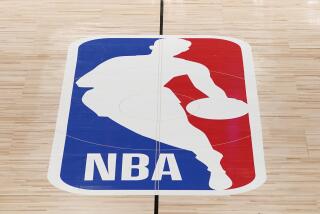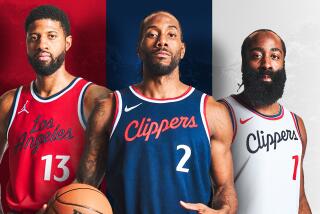Firms Focus on Logos to Project Right Image
- Share via
Image is the corporate idol of the ‘90s. If you have doubts about that, just ask Pepsi’s product-packaging pundits why it took them four years, five design firms and millions of dollars to make a few small changes to their logo.
They’ll tell you the changes make Pepsi appear more modern. They’ll tell you that their former logo was too boxy for the ‘90s. They’ll even tell you this: “Package design is like a product’s clothing,” one Pepsi spokesperson said. “It needs to fit the times.”
When Pepsi placed its new logo on parade last week, it wasn’t just to appear more hip. It was also to deliver a swift kick to its already reeling rival Coke.
Coke redesigned its packaging a few years ago. But Pepsi waited nearly 14 years--until the moment was right to strike. Now Pepsi can rightfully boast that, not only do consumers like its advertising more but it also has the freshest image on the market.
“This business is only a little bit of designing and a lot of thinking,” said Ronald Peterson, managing partner at Peterson & Blyth Associates, the New York City firm that helped redesign the Pepsi logo.
This trend toward package and logo redesign really picked up steam in 1990 and should go into overdrive before the turn of the century. Today, the idea is to be in sync with the ‘90s. But in a few years, look for a parade of logos and package redesigns with corporate eyes aimed at the images of the next century. Most say they want “global” images that will stand for the same thing wherever their products are sold.
As mass advertising costs grow more prohibitive, makers of consumer products continue to look for ways to get their products to stand out--and essentially advertise themselves. Keep in mind, most supermarket purchase decisions are made at the last second. The decisions can be very confusing considering that the typical grocery store stocks 20,000 different items.
Consumers rarely benefit from package redesigns. More often, it’s the company that benefits should product sales magically improve just by wrapping items in flashier packages.
Earlier this year, Kentucky Fried Chicken introduced a new logo, and last week it brought out a brighter bucket. Procter & Gamble recently redesigned its moon and stars symbol and at the same time created two new logos that the company will eventually use in product packaging.
Over the past year, Bristol-Myers perked up the packaging of many of its products, including Ban roll-on deodorant. Rice-A-Roni and Campbell’s Chunky Soups also did packaging redesigns. And McDonald’s made its packaging more environmentally sensitive, as did the makers of L’Eggs hosiery.
Southern California Gas Co. expects to spend nearly $500,000 to give a more up-to-date feel to its familiar flame logo. “In the past we were considered as those stodgy people who sold gas molecules,” said Roy Rawlings, vice president. “But we’re moving into high-tech areas like natural gas vehicles. We want our logo to reflect that.”
Many companies that redesign packaging turn to highly specialized research firms that track consumer reaction by using computers that carefully monitor exactly how and where consumers’ eyes look at products stocked on store shelves. “The object is to get consumers to look at your product first,” said Joe Schurtz, executive vice president at the Englewood Cliffs, N.J., research firm Perception Research Services.
Pepsi paid consumers to view screens that projected lightening-fast flashes of the newly designed cans on store shelves. Consumers were then asked if they remembered--or even recognized--the Pepsi cans. Among the best remembered was the logo that debuted last week.
Although the product should stand out, a redesign of the package should never make the product unrecognizable. “You don’t want to destroy the equity of the logo,” said Peterson, whose firm did Pepsi’s redesign. “You just want to make it more contemporary.”
When Coke redesigned its packaging several years ago, it turned to the San Francisco design firm Landor Associates for “a look to take it into the next decade,” said Michael Livolsi Jr., principal at Landor. “But at the same time (Coke) wanted to keep its heritage. . . . In the ‘90s, every presentation of the product must enhance Coke’s image.”
Like Pepsi, Coke was also looking for a single, worldwide image for all of its brands. The design firm developed nearly 800 different designs from which the present one was selected.
Sometimes, logo and package redesigns have as much to do with erasing the past as they do with creating the future. Procter & Gamble recently modernized its century-old man-in-the-moon trademark that some religious cults linked with satanism. At the same time, the consumer products giant developed a “P&G;” logo and another logo with its name.
Just how it will use each of these logos--and which will appear on what products--is still not known. “The transition will take years,” said Terry Loftus, a company spokesman. But with P&G; products sold in 50 countries, the firm wants a single logo that identifies it.
Earlier this year, Kentucky Fried Chicken changed its name to “KFC.” It created a new logo to reflect that--and most recently it began to test a new bucket. Just how big a deal is this? Said company spokesman Steve Provost, “This is the most dramatic move for KFC in 40 years.”
Briefly . . .
The troubled Clio Awards were purchased Monday for an undisclosed sum by a Chicago-based investor group led by Ruth Ratny, publisher of the trade magazine Screen. . . . The Los Angeles agency Scott/Lancaster has won the $6-million print ad business from Russ Berrie & Co., an Oakland, N.J.-based marketer of impulse gifts. . . . A Federal Trade Commission law judge has ruled that Schering Corp., the U.S. distributor of Fibre Trim, marketed the weight-loss drug without adequate proof of its weight-loss claims. . . . NatureWorks, which markets herbal-based health and beauty products, has handed its ad business to the Agoura Hills agency Meade Ullman. . . . NBA all-time assist-leader Magic Johnson has signed on as a spokesperson for Nestle Crunch.
New Looks for the ‘90s New Procter & Gamble / Old Procter & Gamble New Pepsi / Old Pepsi These are just a few of the major consumer product companies that have redesigned their corporate logos or product packaging during the past several years in hopes of improving their images with consumers--and bolstering sales. Company / product: Pepsi What was redesigned?: Logo and packaging Why: Wants a single “global” image Company / product: Coke What was redesigned?: Logo and packaging Why: Wants a single “global” image Company / product: KFC What was redesigned?: Logo and packaging Why: Wants to look more modern Company / product: Procter & Gamble What was redesigned?: Logos Why: Wants a single “global” image Company / product: Bristol-Myers What was redesigned?: Product packaging Why: Wants to look more modern Company / product: Rice-A-Roni What was redesigned?: Package Why: Wants to look more modern Company / product: Campbell’s Chunky Soup What was redesigned?: Label Why: Wants to look more appealing Company / product: S. California Gas Co. What was redesigned?: Logo Why: Wants to look more modern Company / product: Quaker Oats What was redesigned?: Cereal boxes Why: Wants to look more appealing Company / product: L’Eggs What was redesigned?: Package Why: Wants to look more environmental Company / product: McDonald’s What was redesigned?: Food containers Why: Wants to look more environmental
More to Read
Inside the business of entertainment
The Wide Shot brings you news, analysis and insights on everything from streaming wars to production — and what it all means for the future.
You may occasionally receive promotional content from the Los Angeles Times.










